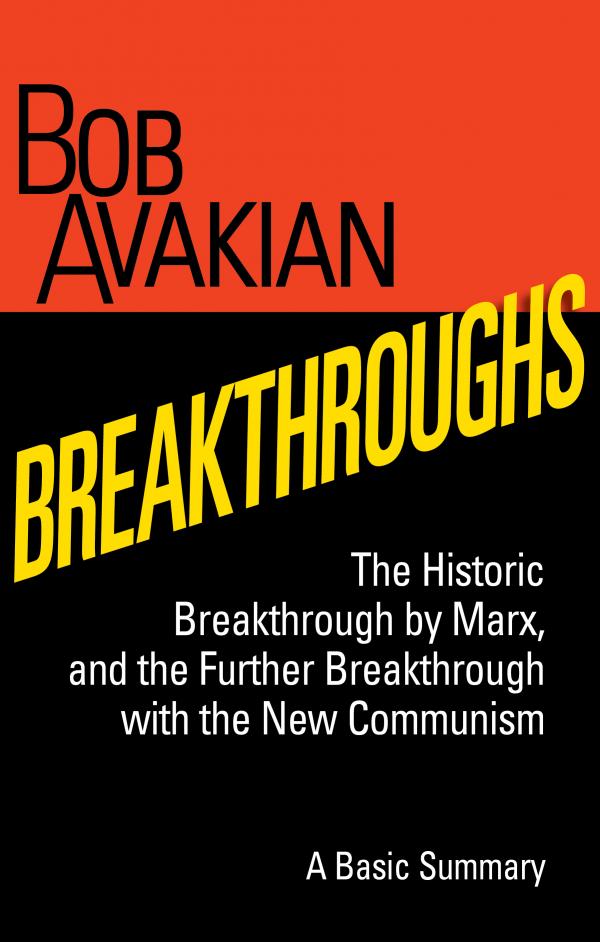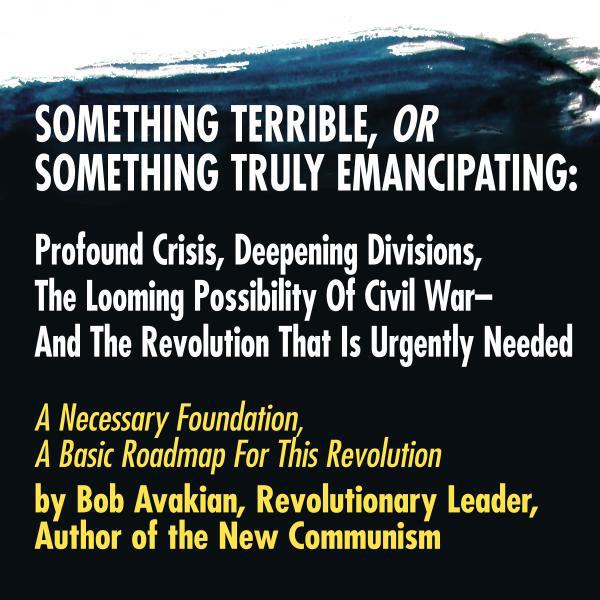Watch a video of Raymond Lotta's speech and discussion with audience at Revolution Books, NYC
Watch a video of Raymond Lotta's speech and discussion with audience at Revolution Books, NYC
Some of you here may know about the science-fiction series 3 Body Problem, and may be watching it. Some of you may not be familiar with it. But all of you should know two things.
First, this show is a major cultural phenomenon—being watched by millions around the world.
Second, through the medium of story-telling, it is a major ideological assault on communism... on Mao Zedong, who was the greatest revolutionary of the mid-20th century... and on the Cultural Revolution of 1966-76, an overwhelmingly liberatory and unprecedented episode in the history of communist revolution, indeed in the history of humanity.
Now I realize that's a mouthful. I'm going to break this down in my talk. But the reason I'm giving this talk is that the stakes are so high.
Look, we face a dire state of emergency: genocide in Gaza... women stripped of the right to abortion... fascism on a rampage... the climate crisis careening towards catastrophe... the growing danger of world war, of nuclear war. The system we live under, the system that rules over you, capitalism-imperialism, is the cause of this—with the U.S. the #1 oppressor and plunderer in the world.
But there is a way out of this horror: a revolution guided by the new communism developed by the revolutionary leader Bob Avakian. A revolution to emancipate humanity and protect the planet. A revolution to change everything! This revolution is not only so badly needed. It is also more possible—with the rulers at each other's throats and society being torn apart.
Yet no sooner do you hear that word “communism,” than you start thinking: “isn't communism long dead, something that everyone knows is a failure.” Isn't it a system of “mass control,” “mass conformity,” and “senseless violence” that promises a paradise but leads to nightmare?
Well, that's not what you independently think and know, it's what you've been trained to think and know... what's been drilled into your head by this system—by its “experts” and ideologues, through its media and highly promoted memoirs. All telling you, warning you, that you cannot get beyond capitalism... that if you try, it'll be a disaster. Long live selfishness, inequality, and exploitation.
This is the anti-communist brainwash you're getting. It seeps into every pore of intellectual, political, and cultural life. Keeping you ideologically locked into this system, in ways you're not even aware of.
The Big Problem with 3 Body Problem
Which brings us to Exhibit A: the Netflix series 3 Body Problem that began streaming in late March. It's a science fiction story based on a hugely popular, contemporary Chinese novel. The Netflix adaptation introduces you to several young scientists in astrophysics and nanotechnology, working in London. Their sophisticated research centers are receiving nonsensical results that overturn a decade of carefully collected data. Around the same time, a number of scientists commit suicide for no apparent reason. Other strange things happen—like stars one night getting brighter, and then flickering on and off; apparently, an outer worldly force is trying to get humanity's attention. There's a lot of spectacle here from the creators of Game of Thrones.
But what I'm focusing on here, and what is key to the story-line—setting it in motion and an ongoing theme—is the Cultural Revolution in China. Not the Cultural Revolution as it really was in its main and overwhelmingly positive and profoundly liberatory aspect. But a vicious, anti-communist misrepresentation that not only serves as a thematic anchor of the series but reinforces the official bourgeois narrative of the Cultural Revolution.
The opening scene of 3 Body Problem takes place on an outdoor stage emblazoned with revolutionary banners. An astrophysicist is forcibly seated at the center, hounded by young followers of Mao. They are accusing him of subscribing to “bourgeois and imperialist science”: Einstein and the theory of relativity; and theory of the Big Bang, about the start of the universe in its present configuration. He is told he must recant, because the Big Bang explanation is said to allow for the existence of God. He refuses. The physicist's wife denounces him. His interrogators grow more violent and beat him repeatedly. The assembled crowd cheers all this on.
The physicist's daughter, herself a brilliant scientist, is in that crowd. She watches in horror as her father is tormented and then killed. She becomes a central character in the saga. To protect herself from prison and worse—and this is a vicious caricature of the Cultural Revolution as a massive lock-up—she agrees to become part of a top secret scientific project in Maoist China. Researchers are working on sending signals to extraterrestrial species. In taking up this post in this remote region, she witnesses what the film falsely portrays as a Maoist war on nature in order to develop the economy.
She assumes major research responsibility in this secret government project. And she ultimately makes contact with extra-terrestrials. And then makes a fateful decision that invites an alien invasion to colonize Earth. Why? To save humanity from its destructive impulses, the worst of which—we are told—were in full display during the Cultural Revolution. This is the fatalism of 3 Body Problem—there is no hope for humanity.
You, the viewer, are left with this bogus and lurid picture of the Cultural Revolution—as a decade-long campaign of fanatical mob terror, as anti-intellectual and anti-science, as utterly heedless towards the environment. Taking this film as a source of knowledge about the Cultural Revolution would be equivalent to trying understand the U.S. Civil War and the radical period of Reconstruction following the Civil War according to the racist film Birth of a Nation, which utterly distorts those events as the unmitigated horror of freed slaves wreaking havoc on society.

***
Now I am a follower of the revolutionary leader Bob Avakian. Over the last four decades and more, he has developed the new communism. He has summed up the experience of the first stage of communist revolution—the Russian Revolution of 1917-56 and the Chinese Revolution of 1949-76. He has drawn from diverse spheres of human endeavor and understanding—and analyzed the great changes that have taken place in the world. There are different dimensions to this new communism.
But at its core is the search for the truth—a consistently and thoroughly scientific approach to reality. This scientific approach means engaging with all of reality... learning from all spheres of life... fostering intellectual-cultural ferment... and learning from diverse political and ideological streams and perspectives, even those opposed to socialism but which may be getting at important aspects of truth.
Avakian has put it provocatively: all truths will help us get to communism—to a world without exploitation and oppression, to a world community of humanity of freely cooperating human beings, no longer divided into classes and marked by antagonistic social conflict. All truths will help us get to communism—even truths about the experience of socialist revolution “that make us cringe.” Truth is objective, what corresponds to reality. And getting at the truth requires identifying the main and defining features and trends of a phenomenon—so that we can understand and evaluate it.
The point of this scientific approach to understanding reality in the fullest and deepest possible ways... is to transform reality in the most profound and revolutionary way.
REVOLUTION 23: Truth is...Truth
Getting at the truth of the Cultural Revolution means recognizing its liberatory aims, methods, and achievements—which were its overwhelmingly main aspects. But also confronting the shortcomings and problems, even quite serious ones, of the Cultural Revolution.
And being thoroughly truthful and evidence-based requires asking and investigating whether there might be some truth to the portrayal in 3 Body Problem of how struggle was conducted during the Cultural Revolution. Is there anything to its depiction of the ways certain scientific theories were received and assessed during the Cultural Revolution? Even a grain of truth in this sea of lies about the Cultural Revolution. The new communism demands this of us. It has everything to do with how, on the basis of the new communism, we can make a qualitatively more emancipating revolution in today's world.
I mentioned the first stage of communist revolution. The Russian revolution of 1917-1956 and the Chinese revolution of 1949-76 were the first and historic attempts to create societies free from exploitation and oppression. They accomplished incredibly inspiring things against enormous odds. They faced unremitting pressure and threat from imperialism—including, in the case of the socialist Soviet Union, massive, genocidal military onslaught by fascist-imperialist Germany. Within a year of the victory of the Chinese revolution in 1949, the U.S. imperialists were moving up the Korean peninsula and threatening nuclear strikes against China.
For all these difficulties and challenges, the first stage of communist revolution opened a whole new chapter in human history. The Soviet Union and revolutionary China created the world's first planned socialist economies that served the needs of people, not the enrichment of the few. These revolutions took the emancipation of women as a fundamental point of orientation. In the case of Mao and the Cultural Revolution, society was “sprung into the air” and revolutionized in ways unheard of in human history. The formerly oppressed and exploited were empowered to take ever greater responsibility for the direction of society.
But these revolutions were also constrained by problems in the method and approach guiding them. The new communism, while upholding and building on the first stage of communist revolution, also ruptures in important ways with aspects of previous communist theory and practice. Importantly, it decisively breaks with the poisonous notion that the “ends justify the means,” which has infected the communist movement. The means and methods of revolution must flow from and serve the goal of getting to a world without exploitation and oppression.
The Truth of the Cultural Revolution
With this foundation, I want to turn to the Cultural Revolution, to its historical backdrop and lessons.
In 1949, the Chinese revolution, mobilizing millions under Mao's leadership, came to power. It drove out foreign imperialism. It shattered the old oppressive economic and social order in which landlords despotically ruled over peasants in the countryside and a corrupt capitalism led to horrific exploitation and destitution in the cities. The revolution put an end to that.
It carried out the most extensive land reform in history. It established a new socialist state power and economy geared to meeting basic needs of the people. Under Mao's leadership, the revolution forged new liberatory institutions and new cooperative and collective relations among people. It carried out literacy and health campaigns, and waged struggle against the deeply-entrenched subordination of women. In 1949, China, a country of 500 million had only 12,000 doctors trained in modern medicine! By 1965, there were over 200,000.
But even as the revolution progressed, Mao analyzed that China was still a society marked by social inequalities and differences. For instance, there still existed a wide gap between economic-social conditions in the countryside and higher development in the cities. There was still a division of labor in society where the majority of people were mainly engaged in manual labor, while a minority was mainly engaged in the realm of ideas and administrative activity. There were still differences in income, and it was still necessary to use money. These things can't be eliminated overnight. But they must be restricted and transformed to get to a world without oppression. And there are the vestiges of the culture, ways of thinking, and values of the old society.
Mao went further. He analyzed that these inequalities and social differences generate new privileged forces, including a new bourgeois-capitalist class within socialist society. And its power center was at the top levels of the communist party, and at the highest levels of the socialist state. Why was this where their power resided, and where they had the leverage to influence the direction of society? Because the communist party is the leading political institution in socialist society—and the socialist state economy is the heart of the new economic system.
These new privileged forces, these “capitalist roaders” as Mao described them, aimed to take China down the capitalist road. Mao and the revolutionary forces represented and fought for the socialist road: to deepen and carry forward the revolution to overcome these inequalities and differences. But the capitalist roaders had tremendous strength and influence in the Communist Party, at the highest levels of governance, and in the military.
They pushed a program of putting the economy on a profit-based footing, of telling workers to keep their noses to the grindstone—don't look up to the larger issues of society and the world... this in the name of creating a more “efficient socialism” that would raise living standards. They fought to put the educational system on an ever-more elitist foundation—in the name of creating a more expert-based society. And they implemented these kinds of policies where they had sufficient control and influence. By 1965, they had positioned themselves and were maneuvering to seize power in society as a whole.
This was the real-world backdrop of the Cultural Revolution launched by Mao in 1966! (The anti-communist brainwash keeps you totally ignorant of this!) Mao analyzed that a “second revolution” was needed: to prevent the restoration of capitalism, and to keep China on the socialist road, to further revolutionize society and contribute to the advance of the world revolution.
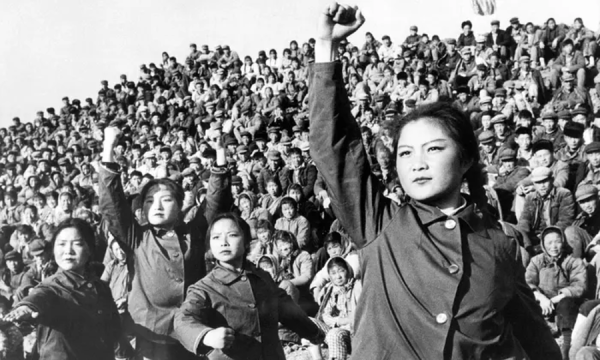
Chinese Red Guard, 1966: Mao turned to young people, with their rebellious and questioning spirit, to spark the Cultural Revolution. In the schools, these radical youth formed into Red Guards, inspiring revolutionary initiative and creativity.
The communist party had grown stale and calcified. So Mao turned to young people, with their rebellious and questioning spirit, to spark this “second revolution.” In the schools—which not only transmit knowledge but values and attitudes—these radical youth formed into Red Guards and challenged educational authority that promoted knowledge as a means of self-advancement at the expense of social good and social transformation, that quashed revolutionary initiative and creativity.
The Red Guards went into factories to stir up critical thinking among workers, calling on them to examine the content of management and organization of the workplace—and to resist oppressive authority. They promoted study of Mao's writings. They went into the countryside to open peasants' eyes to, and draw peasants into, this great struggle between the capitalist and socialist road.
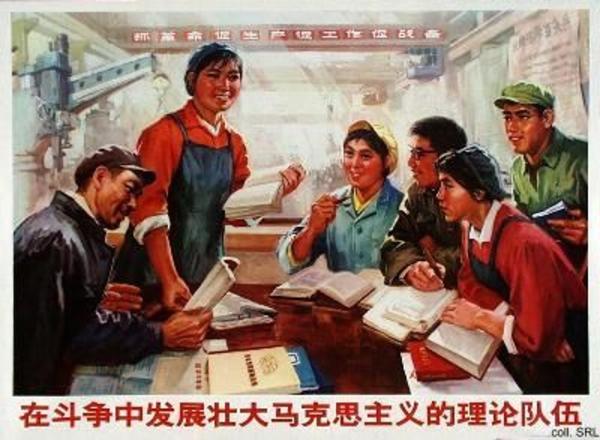
Poster featuring workers in a factory studying and discussing revolutionary theory.
In reflecting on the Cultural Revolution, Mao explained that he was searching for a way to expose our “dark aspects” from below. To prevent the restoration of capitalism—NOT through purges, arrests, and executions BUT by awakening and mobilizing tens and hundreds of millions of workers, peasants, students, and professionals to take part in political and ideological struggle to overthrow these capitalist roaders—and to carry the revolution forward into all spheres and institutions of society—including the vanguard communist party. And to do this through methods and means that would not only enable the masses of people to raise their understanding of the contradictions and challenges involved in getting to a communist world without exploitation and oppression... BUT ALSO to transform their own thinking, to break with old ideas and customs that reinforce self-first, privilege, and passivity.
The principle of “serve the people” was promoted, and became a measure for evaluating how society was functioning.
Methods of Struggle
No, this was not vindictive “mob terror” as 3 Body Problem and the bourgeois-imperialist accounts of the Cultural Revolution would have you believe. Let's look at the main forms of struggle of the Cultural Revolution:
—There was mass debate—over policy and the direction of society. In all kinds of public forums at all levels of society, through newspapers (in Beijing there were over 900 new newspapers) and what were called “big-character” posters—handwritten posters displaying large Chinese characters that were used as a means of protest, political messaging, and popular communication. These were means through which people expressed themselves freely—arguing over the big questions of this struggle over the road forward for revolutionary China. Try that at Columbia University today, where the university is banning students from posting pro-Palestine signs in their dorms—not to mention the repression of student protest.
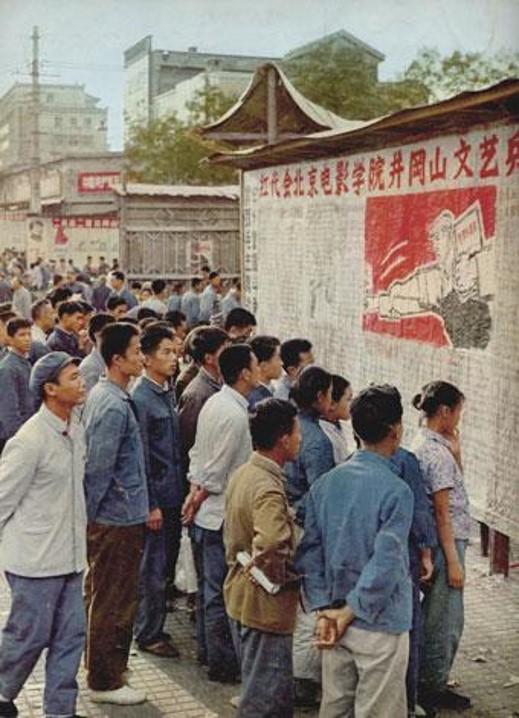
People gathering to discuss a "big-character poster." These posters were popular means of free expression, protest, and political messaging during the Cultural Revolution contributing to the atmosphere of broad debate over policy and direction of society.
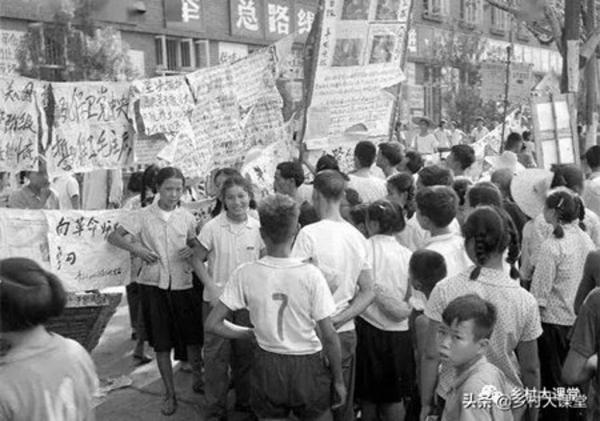
—There was mass political mobilization: demonstrations, strikes, and protests. Even uprisings, such as what happened in Shanghai in early 1967, when revolutionary workers rose up to politically challenge and overthrow the capitalist roaders who ruled the city. What followed was further debate and experimentation—which with Maoist leadership led to the development of new revolutionary-participatory forms of governance and administration.
—And there was mass criticism that took place in public gatherings and assemblies—criticism of high-ranking authorities promoting capitalist-style policies and programs. And also criticism more broadly of administrators and professionals with important responsibility who came under the influence of bourgeois-elitist outlook and had grown detached from basic people. No authority at any level was exempt from criticism.
All of what I am describing is what I mean when I say that the Cultural Revolution was “springing society into the air.” This was the deepest-going revolution in human history. And it resulted in pathbreaking transformations and new innovative practices:
There was the forging of new revolutionary committees of political power and administration. There was the inauguration of the “barefoot doctors” movement—educated youth from the cities and peasants who trained to provide preventive medicine in the countryside—some one million trained during the Cultural Revolution, and this contributed to the most egalitarian, needs-based public health system in the world at the time. (Shanghai in the early 1970s, by the way, had a lower infant mortality rate than New York City.)

In the years of the Cultural Revolution, some 1 million young peasants and young people from the cities were trained as "barefoot doctors" providing basic healthcare in the countryside.
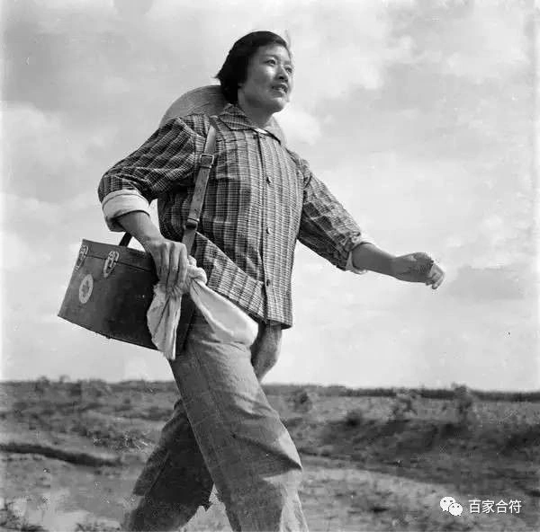
There was the creation of new revolutionary art, ambitious undertakings like the revolutionary reinvention of Chinese opera and ballet—combining traditional and Western forms and techniques with bold, new narratives, like that of the Red Detachment of Women, that put strong, independent women front and center, challenging patriarchal custom and belief. There was the practice of “open-door” scientific research, in which scientists and technical personnel went to factories and the countryside to share knowledge with, and to conduct scientific experiment alongside, workers and peasants—and to learn from peasants.
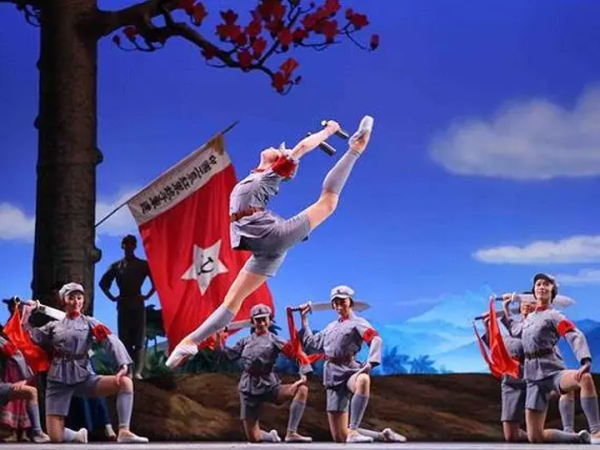
Image from the innovative revolutionary ballet and opera "Red Detachment of Women." This work and others contributed towards radicalizing the discourse of women's liberation during the Cultural Revolution.
What about the claims of mass violence and ugly attacks on people and their work? Is that opening scene of 3 Body Problem, with the astrophysicist being publicly shamed and beaten, an accurate reflection of the main character and spirit of the Cultural Revolution? No, it's a gross distortion. The methods of struggle that I mentioned earlier (mass debate, criticism, and political mobilization) were clearly spelled out in official and widely publicized documents, including this guidance, which I am directly quoting: “Where there is debate, it should be conducted by reasoning and not by force.”
Now acts of violence and beatings, and incidents of public humiliation, did occur during the Cultural Revolution. But here is what the evidence shows:
*This was not the main trend of the Cultural Revolution, and it was assuredly NOT the orientation of Mao.
*When things went in a violent and vengeful direction, Mao and the revolutionary forces condemned and criticized such trends through statements, directives, editorials, and “on-the-ground” interventions, such as a team of workers dispatched to a university in Beijing where Red Guard student groups took up arms against each other.
*Finally, much of the violence fanned during the Cultural Revolution was actually instigated by the capitalist roaders, especially for the purpose of discrediting Mao and the Cultural Revolution.
There's an important methodological point for all of us here to grapple with. Revolutions and great upsurges are complex phenomena. Any appraisal of a period of history, or mass movement, must examine its main elements and features that define its essential nature. Take a current example: the student movement in solidarity with Palestinian people and opposing the genocide in Gaza. The backers and supporters of apartheid Israel argue that this movement is antisemitic. Well, that's reactionary nonsense. Are there elements of antisemitism among some involved in this struggle? Yes, but that's utterly secondary and minor—not what defines and propels this righteous struggle overall.
The Question of Science
I want to return to the issue of science and that scene at the beginning of 3 Body Problem where Einstein's theory of relativity and the Big Bang theory are excoriated as bourgeois and imperialist. Is there any truth to this depiction? There is. And this brings us back to Bob Avakian's insistence on a thoroughly scientific approach to understanding and changing the world. Avakian has emphasized that “the truth... is truth.” But there was not this correct understanding during the Cultural Revolution. In one of the major circulars guiding the Cultural Revolution, it is stated that the bourgeoisie has its truth, and the proletariat has its truth. This is profoundly wrong.
Again, “truth... is truth” no matter who says it. The notion of “class truth” is scientifically wrong, because there's only one world and one reality. It's also an obstacle, as Bob Avakian emphasizes, to getting beyond a world where “might makes right”—where what is accepted as “true” is based on who has the power and authority to declare and enforce it—rather than to what actually corresponds to reality. Scientific theories cannot be evaluated on the basis of the politics, class position, gender (or other) identity of their proponents.
In terms of Einstein and relativity, and the Big Bang—criticism was launched during the Cultural Revolution. That criticism was not based on deep engagement with these theories but on ideological and philosophical suspicions and dogmatic approaches to Marxism. This led some forces of the Cultural Revolution to dismiss these theories out of hand. Why? Because Einstein's ideas might be used to promote relativism about time and space (that they don't objectively exist). Or, in the case of the Big Bang... some declared it erroneous because the theory opens the door to a possible argument for an absolute beginning of the universe... and that could be used to justify the existence of a non-material god. This was not consistent with a deep scientific understanding of the Big Bang theory.
There's more to understand about what was happening. But the influence of this kind of thinking was not only a fetter on the Cultural Revolution, but to what it's going to take to get to communism. So that's some initial reflection on that aspect of the Cultural Revolution.
But using that criterion of identifying the main and defining character of an historical phenomenon, we can determine that the Cultural Revolution was not anti-science. For the record, revolutionary China was undertaking high-energy physics research. During the Cultural Revolution, scientists synthesized the protein for insulin, satellite and computer technology advanced.
At the same time, science was popularized throughout society. Basic primers educated peasants and workers, and challenged superstition. Technical and research institutes, and related factories, would invite people from the neighborhoods to observe and learn from the work being done. In the rural areas, where professional scientists conducted experiments and education alongside peasants—the experience and practical knowledge of peasants was brought into the mix and process of further deepening understanding and further developing sustainable agricultural practices. All this as part of breaking down that ages-old division between mental and manual labor.
The Environment: An Upside-Down Distortion
As for the issue of the Cultural Revolution and the environment—and how 3 Body Problem would have you believe that Mao was waging a war on nature to accelerate economic development, no matter the environmental consequences. This is obscenely wrong. In the first episode, you see forests being cleared. A young official gives the daughter of the astrophysicist who had been killed a copy of Rachel Carson's famous 1962 book Silent Spring. The book exposed the tremendous environmental and health harm caused by the indiscriminate use of pesticides. The audience watching 3 Body Problem is led to think that the West was acknowledging and seriously acting on environmental issues... while this was a taboo topic in Maoist China.
To which I can only say to the Netflix creators of 3 Body Problem... how dare you!?!
In 1961, the year before Silent Spring came out, the U.S. imperialists initiated the most massive and the deadliest campaign of chemical warfare in human history. This was in Vietnam, where the U.S. military, working with major U.S. chemical companies, sprayed herbicides, like Agent Orange, on vast swaths of the countryside. They destroyed some five million acres of forest and food crops, poisoning rivers and canals. It went on for 10 years, until 1971, leaving hundreds of thousands of Vietnamese with birth defects and cancers. All this as part of the U.S.'s genocidal war against the Vietnamese people.
Meanwhile, during the Cultural Revolution, socialist China was coming to new realization of environmental dangers and changed some harmful practices they had previously carried out. Campaigns to plant new forests and reforest other areas were launched. More broadly, there was a new awareness and discourse of economic development that was compatible with environmental protection. Environmental and public health goals were incorporated into local and national economic planning. The revolution gained new knowledge from environmental efforts in other parts of the world.
The Defeat of the Cultural Revolution and the Road Forward NOW: The New Communism
But this kind of learning and experimentation—and it was happening in other spheres of society—was cut short in October 1976, a month after Mao died. From 1973-76, Mao and his revolutionary followers had been leading masses in waging a new phase of political and ideological struggle against the capitalist roaders. This was against the backdrop of intensifying war threats against China by the social-imperialist Soviet Union. In this complicated situation, the capitalist roaders were gaining strength.
In October 1976, these capitalist roaders carried out a reactionary coup. They suppressed the revolutionary forces and set out to systematically restructure Chinese society and economy along capitalist lines. China has become a major capitalist-imperialist power. This terrible defeat marked the end of the first stage of communist revolution and its high point, the Cultural Revolution.
But we are not back to square one. Far from it. The new communism forged by Bob Avakian makes possible a new stage of communist revolution—a qualitatively more emancipating revolution.
Let me come back for a moment to the fatalistic thematic of 3 Body Problem. This series is telling us that humanity is doomed. An alien invasion is coming in 400 years, but the characters argue whether it's even worth stopping this invasion for future generations—because humanity is so irredeemable. The problem is incurable human nature. And it's the Cultural Revolution—which, again, was an incredible breakthrough for humanity—which, in this grotesquely distorted telling, sets this particular doom-loop in motion.
3 Body Problem lets imperialism, U.S. imperialism, off the hook. All its crimes, all its environmental destruction. All that is possible, in the story, is to entrust our fate to a top-secret authority... of the imperialist system!
But there is hope for humanity... hope on a scientific basis. We have something that has never existed before in the history of humanity, with the new communism developed by Bob Avakian.
In summing up the first stage of communist revolution, even the best of that stage, Bob Avakian has pointed to an historic contradiction. Communism is in the highest interests of the masses of people. But not all of them want it at any given time. You can't resolve that contradiction by force-marching them to communism with a gun to their backs. That is, through intimidation and over-reliance on physical and social coercion. You have to be winning people to the cause of and struggle to achieve communism. On the other hand, you need to hold on to power, while ensuring that this power is worth holding on to. For more on this, I urge readers to go to three works by Bob Avakian: The New Communism, particularly Part II; Breakthroughs, particularly pages 17 through 41, and 57 through 74; and the Constitution for the New Socialist Republic in North America.
The Constitution for the New Socialist Republic in North America authored by Bob Avakian embodies the solution to this historic problem. It not only protects dissent (even dissent opposed to socialism) and intellectual and cultural ferment—but promotes that in a way that has never existed in this society—indeed on a scale unseen in human history. In the context of a society that is aiming to end all exploitation and oppression. All this is crucial towards understanding and changing the world—and creating a society that people would want to live in, and could flourish in.
You have to repeatedly win people to fight to stay on the socialist road—relying on evidence, contestation, and debate between different programs and platforms... and critical thinking. And this Constitution also contains provisions for contested elections, in which it would even be possible to vote socialism out of power. But it has safeguards that would make that very difficult. Because, again, communism is in the highest interests of world humanity.
I want to end where I began. The world is a horror. We face truly existential threats in the danger of nuclear war and global warming. But this is also a time of heightened revolutionary possibility.
The document “WE ARE THE REVCOMS” explains: “This is also a 'rare time' when the capitalist-imperialists who rule over us, in this country, are deeply divided in a way they have not been since the Civil War in the 1860s, and the country is being ripped apart, with one section moving toward an outright fascist form of rule, with the other fighting for the horrific way things have been. They cannot resolve these deep divisions, and 'hold the country together' on the basis of the 'normal way' this system has operated—and, in any case, that 'normal way' is full of oppression, destruction, and the real danger of wiping out humanity. For these reasons, this revolution we are working for is urgently necessary and more possible.”
This rare time is an historic opportunity—not a guarantee—but a real chance to leap into a whole new world. And the revcoms, followers of Bob Avakian, are seizing on and working on this rare opening to make revolution.
Constitution for the New Socialist Republic in North America (Draft Proposal)
Authored by Bob Avakian, and adopted by the Central Committee of the Revolutionary Communist Party, USA, 2010
Read and download the PDF
Going Forward to the Emancipation of All Humanity
As I have pointed out on this tour: Yes, the anti-communist brainwash is pervasive, and confuses and disorients people—our current “Exhibit A” being 3 Body Problem. Yes, we have to struggle hard for the truth, and raise people's sights. But we also have a lot going for us. The productive capacity, the technology, the knowledge, the interconnectedness of world humanity open up incredible potential to solve material and social problems and act on the environmental emergency—but only on the basis of a “fundamentally different system.”
We have the rare and unique leadership of Bob Avakian who has rescued the communist project and taken it higher—and who is giving ongoing leadership to this revolution. We have the strategy to make revolution and in the Constitution for the New Socialist Republic in North America we have the vision and blueprint for a liberatory socialist society. This revolution is in the interests of the billions in all parts of the world who are denied a decent life and a future worth living, or any future of all.
To those of you here today, to those of you watching this video, to all who yearn for a radically different and far better world: there is nothing more urgent and nothing more meaningful that you can be doing with your lives... than becoming part of, spreading, and contributing to this revolution to emancipate humanity and protect the planet.

